Identification of keys on a computer keyboard for beginners. Cursor control and additional keys. General purpose hotkeys.
The keyboard is the main tool for managing your computer. Mastering it is a top priority for any user. And having mastered the purpose of special keys and their combinations, you will be able to speed up and facilitate your work.
Basic keyboard key blocks
A regular keyboard consists of 5 key blocks:
- Symbolic (with the image of letters of the Russian and English alphabets, numbers and punctuation marks). To print characters instead of numbers, press and hold the Shift key.
- Additional block numeric keys (on the right side of the keyboard). The button is also located here. Num lock which turns this block on and off.
- Special keys:
- Caps lock- changes the keyboard case ( uppercase letters to lowercase). By default, most computers are configured to print in lowercase letters, after a single press of the Caps Lock button, uppercase letters are printed;
- Enter - usually used to move the blinking cursor to the line below;
- Tab - indents the "red" line;
- Alt, Ctrl - expand the capabilities of the keyboard, when pressed simultaneously with other characters, they give specific commands to the computer.
- Cursor keys in graphic and text editors with arrows that move the cursor up, down, left, right. And also buttons:
- Insert - allows you to activate the mode of inserting / replacing text on the page;
- Delete - deletes the character to the right of the text cursor or the selected text;
- Backspace - deletes the character in front of the cursor;
- Home - move the blinking cursor to the beginning of the text / paragraph;
- End - move the cursor to the end of the page;
- Page up - turns the page up;
- Page Down - turns the page down.
- In addition, there are more keys:
- Esc - closes some programs (browser windows, computer games, and others);
- long empty button - space;
- Print Screen - takes a "photo" of the screen, saves it to the clipboard.
- Function keys (top row, signed with Latin F and numbers from 1 to 12) - together with the previous block, allow you to use the keyboard without a mouse.
- F1 - call Windows help;
- F2 - editing the selected object (renaming files, folders);
- F3 - search activation. Calls up a search box in the system or enables text search in the browser;
- F4 - activates the address bar in Windows Explorer and opens history address bar in the browser Internet Explorer;
- F5 - executes the "update" command, for example, a page on the Internet or system operation;
- F6 - moves the blinking cursor to the address bar of browsers or is used in computer games to maintain the achieved level;
- F7 - F9 - do not have standard functions, their purpose varies depending on the application. In games, F9 usually causes the F6 quicksave to load;
- F10 - call the program menu;
- F11 - switches the windowed mode to full-screen and vice versa, this is convenient, for example, when watching movies;
- F12 - in a text editor Microsoft Word allows you to save the current document.
In general, when getting acquainted with any application, it makes sense to figure out what functions the function keys perform. This can help you make your work easier and faster.
"Hotkeys
Pressing some keys at the same time allows the computer to execute more commands quickly. Such keyboard shortcuts are usually called "hot". The most common ones are:
- Alt + Shift - switch keyboard layout (changes the input language);
- Alt + F4 - close the current window;
- Alt + Ctrl + Del - opens the "Task Manager";
- Ctrl + A - executes the "select all" command;
- Ctrl + X - cut to clipboard;
- Ctrl + C - copy to clipboard;
- Ctrl + V - paste from the clipboard;
- Ctrl + P - print the document;
- Ctrl + S - save the current document.
Features of working with a laptop keyboard
Those who had to work on a laptop keyboard must have noticed that some of the symbols and pictograms differ in color or are framed. Also highlighted is the Fn button in the bottom row to the left of the space bar. When you press Fn and keys of the same color at the same time, special tasks are performed.
Thus, you can change the volume level of the sound and screen backlight, turn on / off the touchpad ( touch pad), put the laptop into sleep mode, and do other things. Which keys are responsible for a particular function depends on the laptop model and the manufacturer's company, this information can be found in the accompanying documents to the computer or by decrypting the pictograms.
Often reading articles on the Internet or instructions for installing a program, you may come across key combinations(Ctrl-C, Ctrl-V, Win-R, Alt-Tab, Alt-F4, etc.). And if you still do not know what they mean, then you can read our article.
This article presents, full list keyboard shortcuts used not only in operating system Windows.
Basic keyboard shortcuts:
Alt + Tab- Switch between windows
Win + Tab- Switch between windows in Flip 3D mode
Win + Up- Maximize window Win + Down- Restore / Minimize Window
Win + Left- Attach window to the left edge of the screen
Win + Right- Snap window to the right edge of the screen
Win + Shift + Left- Switch to left monitor
Win + Shift + Right- Switch to the right monitor
Win + Home- Minimize / Restore all inactive windows
Win + Break (or Pause)- Launch the System element from the Control Panel (Properties item when clicking right click mouse on Computer in the Start menu)
Win + Space- Show desktop
Win + B- Go to the notification area (tray)
Win + D- Minimize windows or restore all windows
Win + E- Launch Explorer
Win + F- Launch built-in dialog Windows search
Win + Ctrl + F- Launch Computer Search from Domain
Win + F1- Launch built-in Windows dialog: Help and Support
Win + G- Display gadgets on top of all windows
Win + L- Lock workstation (current user session)
Win + M- Minimize all windows
Win + P- Show additional display options (extend the desktop by 2 monitors, etc.)
Win + R- Launch the Run dialog box
Win + T- Select the first item in the taskbar (Press again to switch to the next item, Win + Shift + T- scrolls in reverse order)
Win + U- Launch the Ease of Access Center
Win + X- Launch Mobility Center
Win + number- Launch the application from the taskbar ( Win + 1 launches the first application on the left, Win + 2, second, and since)
Win + "+"- Zoom in
Win + "-"- Zoom out
Ctrl + mouse wheel (up / down) on the desktop- increase / decrease desktop icons.
In Explorer:
Alt + P- Show / Hide Preview Area
Task bar:
Shift + click on the icon- Open a new application window
Ctrl + Shift + click on the icon- Open a new application window with administrator privileges
Shift + right click on an icon- Show application menu
Shift + right click on a group of icons- Show menu, restore all / collapse all / Close all
Ctrl + click on a group of icons- Maximize all windows of the group
Note
Key Win located between the keys Ctrl and Alt on the left side (the emblem is drawn on it Windows).
The Menu key is to the left of the right Ctrl.
The combination "key" + "key" means that you must first press the first key, and then, while holding it, the second.
General purpose hotkeys
| Combination & nbsp keys | Description |
|---|---|
| Ctrl + Esc Win | Open the Start Menu |
| Ctrl + Shift + Esc Ctrl + Alt + Delete | Calling up the "Task Manager" |
| Win + E | Launching "Explore" |
| Win + R | Displaying the "Run program" dialog, analogous to "Start" - "Run" |
| Win + D | Minimize all windows or return to original state (radio button) |
| Win + L | Locking the workstation |
| Win + F1 | Opening Windows Help |
| Win + Pause | Opening the System Properties Window |
| Win + F | Open file search window |
| Win + Ctrl + F | Open a computer search window |
| Printscreen | Take a screenshot of the entire screen |
| Alt + Printscreen | Take a screenshot of the currently active window |
| Win + Tab Win + Shift + Tab | Switches between buttons on the taskbar |
| F6 Tab | Move between panels. For example, between the desktop and the Quick Launch panel |
| Ctrl + A | Select all (objects, text) |
| Ctrl + C Ctrl + Insert | Copy to clipboard (objects, text) |
| Ctrl + X Shift + Delete | Cut to clipboard (objects, text) |
| Ctrl + V Shift + Insert | Paste from clipboard (objects, text) |
| Ctrl + N | Create new document, project, or similar action. In Internet Explorer, this opens a new window with a copy of the contents of the current window. |
| Ctrl + S | Save the current document, project, etc. |
| Ctrl + O | Call the file selection dialog to open a document, project, etc. |
| Ctrl + P | Seal |
| Ctrl + Z | Undo the last action |
| Shift | Autoplay CD-ROM lock (hold while the drive reads the newly inserted disc) |
| Alt + Enter | Switching to full screen mode and back (switch; for example, in Windows Media Player or in the shell window). |
Keyboard shortcuts for working with text
| Keyboard shortcut | Description |
|---|---|
| Ctrl + A | Select all |
| Ctrl + C Ctrl + Insert | Copy |
| Ctrl + X Shift + Delete | Cut |
| Ctrl + V Shift + Insert | Insert |
| Ctrl + ← Ctrl + → | Jump by words in the text. Works not only in text editors. For example, it is very convenient to use in the address bar of the browser |
| Shift + ← Shift + → Shift + Shift + ↓ | Text selection |
| Ctrl + Shift + ← Ctrl + Shift + → | Selecting text by words |
| Home End Ctrl + Home Ctrl + End | Move to the beginning-end of a line of text |
| Ctrl + Home Ctrl + End | Move to the beginning-end of the document |
Keyboard shortcuts for working with files
| Keyboard shortcut | Description |
|---|---|
| Shift + F10 Menu | Display context menu the current object (similar to right-clicking). |
| Alt + Enter | Calling "Object Properties" |
| F2 | Renaming an object |
| Ctrl-drag | Copying an object |
| Shift drag | Moving an object |
| Drag with Ctrl + Shift | Create a shortcut to an object |
| Ctrl clicks | Selecting multiple objects in random order |
| Shift clicks | Selecting multiple adjacent objects |
| Enter | Same as double click by object |
| Delete | Deleting an Object |
| Shift + Delete | Irrevocable deletion object without placing it in the basket |
Keyboard shortcuts for working in File Explorer
Keyboard shortcuts for working with windows
| Keyboard shortcut | Description |
|---|---|
| Alt + Tab Alt + Shift + Tab | Calling the menu for switching between windows and navigating through it |
| Alt + Esc Alt + Shift + Esc | Move between windows (in the order in which they were launched) |
| Alt + F6 | Switching between multiple windows of the same program (for example, between open windows WinWord) |
| Alt + F4 | Close the active window (running application). On the desktop - invoke the Windows shutdown dialog |
| Ctrl + F4 | Closing the active document in programs that allow simultaneous opening of several documents |
| Alt F10 | Calling the window menu |
| Alt + - (minus) | Call the system menu of a child window (for example, a document window) |
| Esc | Exit the window menu or close an open dialog |
| Alt + letter | Calls a menu command or opens a menu column. The corresponding letters in the menu are usually underlined (either initially, or become underlined after pressing Alt). If the menu column is already open, then to call the team you want you must press the key with the letter that is underlined in this command |
| Alt + Space | Calling the window system menu |
| F1 | Call the application help. |
| Ctrl + Up Ctrl + Down | Scrolls text vertically or moves up and down through paragraphs of text. |
Keyboard shortcuts for working with dialog boxes
Keyboard shortcuts for working in Internet Explorer
| Keyboard shortcut | Description |
|---|---|
| F4 | Displaying a list of the Address field |
| Ctrl + N F5 | Launching another instance of the browser with the same web address |
| Ctrl + R | Refresh the current web page |
| Ctrl + B | Opens the Arrange Favorites dialog box |
| Ctrl + E | Opens the Search panel |
| Ctrl + F | Launching the search utility |
| Ctrl + I | Opens the Favorites panel |
| Ctrl + L | Opens the "Open" dialog box |
| Ctrl + O | Opens the "Open" dialog box, similar to the action CtrL + L |
| Ctrl + P | Opens the Print dialog box |
| Ctrl + W | Closing the current window |
| F11 | Switch to full screen mode and back (works in some other applications as well). |
Special abilities
- Press the key SHIFT Five times: Turn Sticky Keys on or off
- Keep pressed right key SHIFT eight seconds: enable or disable input filtering
- Hold down the Num Lock key for five seconds: Toggle sound on or off
- Alt left + Shift left + Num lock: Turn keyboard pointer control on or off
- Alt left + Shift left + PRINT SCREEN: enable or disable high contrast
When writing a letter or entering numerical data, the keyboard is the primary means of entering information into the computer. But did you know that the keyboard can also be used to control the computer? Learning just a few simple keyboard commands will help you work more efficiently on your computer.
This article will cover the basics of working with the keyboard.
Keys organization
The keyboard keys are divided into several groups, depending on their function:
- Dial keys (alphanumeric). These keys include the same keys with letters, numbers, punctuation marks, and symbols.
- Control keys. These keys are used individually or in various combinations to perform specific actions. The most commonly used control keys are CTRL, ALT, the Windows logo key, and ESC.
- Function keys. Function keys are used to perform special tasks. They are designated as F1, F2, F3 and so on up to F12. The functionality of these keys is different and depends on the program.
- These keys are used to navigate documents and edit text, as well as web pages. These include the arrow keys, HOME, END, PAGE UP, PAGE DOWN, DELETE, and INSERT.
- The numeric keypad is convenient for entering numbers quickly. The keys are grouped in a block, as in the usual one.
The following illustration shows the location of these keys on a conventional keyboard. Keyboards may vary.
Keyboard shortcuts
Keyboard shortcuts are a way to perform actions using the keyboard. They are called keyboard shortcuts because they speed up your work. Indeed, almost any action or command performed by the mouse can be performed faster by one or more keys. And it is advisable to master them at an early stage of learning.
In most programs, you can perform actions using the keyboard. To see commands with keyboard shortcuts, open the menu. Combinations, if any, appear next to the menu items.
A plus sign (+) between two or more keys indicates that these keys must be pressed in combination. For example, in the window Firefox browser CTRL + N means "press and hold CTRL and then press N". CTRL + SHIFT + W means "press and hold CTRL and SHIFT and then press W".
![]()
You can use the keyboard to open menus and select commands and other options. If you press ALT in a menu program, one of the letters in each menu name becomes underlined. Press the key with the underlined letter to open the corresponding menu. Press the key with the underlined letter of the menu item to select the corresponding command.
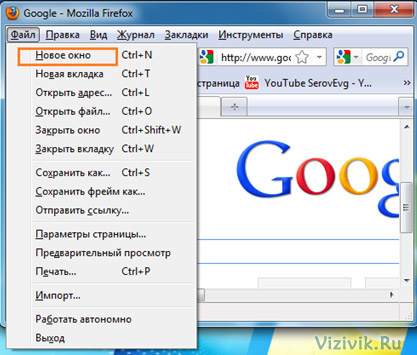
For example, in a Firefox browser window, press Alt + F to open the File menu, then press H to select the Open New Window command
Useful keyboard shortcuts
Let's take a look at the most useful keyboard shortcuts. Keyboard shortcuts make it easier to use your computer by eliminating the need to use your mouse frequently. It is advisable not just to read them, but be sure to apply them when working at a computer. And soon, you will see how convenient it is.
| Key | Action |
|---|---|
| Windows logo key | Opening the Start Menu |
| ALT + TAB | Switching open programs or windows |
| ALT + F4 | |
| CTRL + S | Save current file or document (works in most programs) |
| CTRL + C | |
| CTRL + X | |
| CTRL + V | Insert selection |
| CTRL + Z | Cancel action |
| CTRL + A | |
| F1 | Calling Help for a program or Windows |
| Windows logo key + F1 | Calling Windows Help and Support Center |
| ESC | Canceling the current job |
| Context menu key | Opens a menu with commands related to the selected program elements. Equivalent to right-clicking the selected item. |
Easy Access Keyboard Shortcuts
Basic keyboard shortcuts
| Press the key | Action |
|---|---|
| F1 | Help output |
| CTRL + C | Copy the selected item |
| CTRL + X | Cut the selected item |
| CTRL + V | Insert selection |
| CTRL + Z | Cancel action |
| CTRL + Y | Repeat action |
| DELETE | Removing the selected item to the "Trash" |
| SHIFT + DELETE | Removing the selected item without placing it first in the "Trash" |
| F2 | Rename the selected item |
| CTRL + RIGHT ARROW | Move cursor to the beginning of the next word |
| CTRL + LEFT ARROW | Move cursor to the beginning of the previous word |
| CTRL + DOWN ARROW | Move the cursor to the beginning of the next paragraph |
| CTRL + UP ARROW | Move the cursor to the beginning of the previous paragraph |
| CTRL + SHIFT + ARROW KEY | Select a piece of text |
| SHIFT + any arrow key | Select multiple items in a window or desktop, or select text in a document |
| CTRL along with any arrow key + SPACEBAR | Selecting multiple individual items in a window or desktop |
| CTRL + A | Select all elements in a document or window |
| F3 | Search for a file or folder |
| ALT + ENTER | Displaying the properties of the selected item |
| ALT + F4 | Close the current element or exit the active program |
| ALT + SPACEBAR | Display the context menu of the active window |
| CTRL + F4 | Closing the active document (in programs that allow simultaneous opening of several documents) |
| ALT + TAB | Moving from one open item to another |
| CTRL + ALT + TAB | Use the arrow keys to move from one open item to the next |
| Windows logo key + Tab | |
| ALT + ESC | Cycle through items in the order in which they were opened |
| F6 | Cycle through screen elements in a window or desktop |
| F4 | Displaying the Address Bar List in Windows Explorer |
| CTRL + ESC | Opening the Start Menu |
| F5 | Refresh the active window |
| ESC | Canceling the current job |
| CTRL + SHIFT + ESC | Opening the task manager |
| Pressing SHIFT when a CD or flash memory is inserted | Preventing CD from being played automatically |
Keyboard shortcuts on Microsoft keyboards
| Press the key | Action |
|---|---|
| Windows Key with Windows logo | Opening or Closing the Start Menu |
| Windows Logo Key + PAUSE | Opening the System Properties Dialog Box |
| Windows Logo key + D | Displaying the desktop |
| Windows Logo key + M | Minimize all windows |
| Windows Logo key + Shift + M | Restore minimized windows to desktop |
| Windows Logo key + E | Opening the Computer Component |
| Windows Logo key + F | Search for a file or folder |
| Windows Logo key + L | Locking the computer or switching users |
| Windows Logo key + R | Opening the Run Dialog Box |
| Windows Logo key + T | Cycle through programs on the taskbar |
| Windows Logo key + Tab | Cycle through programs on the taskbar with using Windows Flip 3-D |
| CTRL + Windows key + Tab | Use the arrow keys to cycle through programs on the taskbar using Windows Flip 3-D |
| Bring all widgets to the front and select the Windows sidebar | |
| Windows Logo key + U | Opening the Ease of Access Center |
| Windows Logo key + X | Center opening mobile devices Windows |
| Windows Logo Key + Spacebar | Bring all widgets to the front and select the sidebar |
| Windows Logo key + G | Cycle through sidebar widgets |
| TAB | Cycle through sidebar controls |
Navigation keys allow you to move the cursor, navigate documents and web pages, and edit text. Let's take a look at some of the main functions of these keys.
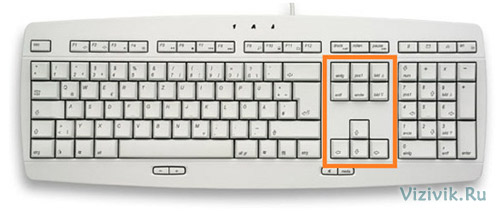
| Key | Action |
|---|---|
| LEFT ARROW, RIGHT ARROW, UP ARROW, and DOWN ARROW | Move the cursor or highlight a single space or line in the direction of the arrow, scroll a web page in the direction of the arrow |
| HOME | Move cursor to the beginning of a line or go to the beginning of a web page |
| END | Move cursor to the end of a line or go to the end of a web page |
| CTRL + HOME | Go to the beginning of the document |
| CTRL + END | Move to the end of the document |
| PAGE UP | Move cursor or page up one screen |
| PAGE DOWN | Move cursor or page down one screen |
| DELETE | Deleting a character after the cursor or selected text; on Windows - delete the selected item and move to the trash |
| INSERT | Turns insert mode on or off. When the insert mode is on, the text you type is inserted at the cursor location. When insert mode is off, the text you type overwrites existing characters. |
The numeric keypad contains numbers from 0 to 9, arithmetic operators + (addition), - (subtraction), * (multiplication), and / (division), as well as a decimal point just like on a calculator or counting machine. Although these characters are duplicated by other keys, their placement on the numeric keypad allows you to quickly enter numeric data or math operations with one hand.

Press the NUM LOCK key to enter numbers on the numeric keypad. Most keyboards have a NUM LOCK indicator light. When NUM LOCK is off, the numeric keypad functions as a second set of navigation keys (functions are shown on the keys next to numbers and symbols).
The numeric keypad is suitable for simple calculations, such as in the Calculator program.
So, we have considered almost all the keys that can only be used. But for the sake of the most curious, let's explore the three most mysterious keys on the keyboard: PRINT SCREEN, SCROLL LOCK and PAUSE / BREAK.

PRINT SCREEN (or PRT SCN)
A long time ago, this key really did what was written on it - it sent text from the screen to the printer. Pressing PRINT SCREEN today takes an image of the entire screen ("screenshot") and copies it to the clipboard in the computer's memory. From there, you can paste (CTRL + V) this image into Microsoft Paint or another program and, if necessary, print it from there.
It is not even clearer SYS RQ on the same PRINT SCREEN key of some keyboards. Historically SYS RQ was conceived as a system request, but this command is not included in Windows.
Advice! Press ALT + PRINT SCREEN to capture only the active window, not the entire screen.
SCROLL LOCK (or SCR LK)
In most programs, pressing SCROLL LOCK has no effect. In some programs, pressing the SCROLL LOCK key changes the behavior of the arrow keys, as well as the PAGE UP and PAGE DOWN keys; pressing these keys allows you to scroll the document without changing the position of the cursor or selection. The keyboard may have a SCROLL LOCK indicator light.
PAUSE / BREAK
This key is rarely used. In some older programs, pressing this key would pause the program or, in combination with CTRL, stop its execution.
Some modern keyboards have “multimedia keys” that allow you to quickly, with one press, access programs, files, or commands. Other models have volume controls, scroll wheels, scale wheels, and other gadgets. Detailed description for these features, see the documentation that came with your keyboard or computer, or the manufacturer's website.

Using the keyboard correctly can help prevent pain and injury to your hands, wrists, and forearms, especially when you use your computer for a long time. Here are some tips for avoiding problems.
1. Place the keyboard at elbow level. Keep your shoulders relaxed.
2. Place the keyboard straight in front of you. If your keyboard has a block of numeric keys, you can accept the space bar as the center.
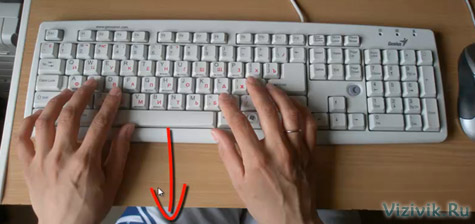
3. When typing, your hands and wrists should move freely above the keyboard, reaching the remote keys without stretching your fingers.

4. Do not place your palms or wrists on any surface while typing. If your keyboard has a palm rest, use it only when interrupting typing.
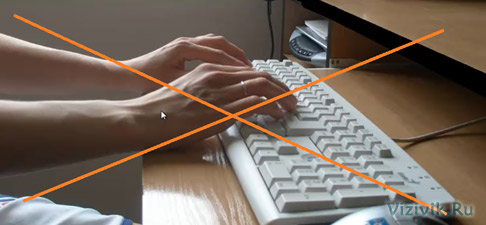
5. When typing, touch the keys lightly and keep your wrists straight.
6. Relax your hands when not typing.

7. While working on your computer, take short breaks every 15 to 20 minutes.
An ordinary keyboard can be roughly divided into several areas.
The uppermost area of the keyboard contains keys that are not used to enter data into the computer. These keys perform auxiliary actions, which are shown in the table below.
Esc key - this key is used to cancel an action, exit programs, games, exit applications, etc.
Functions of the "Esc" key .
Its main function is to cancel the command that was ahead. If you open the menu with the right mouse button on the desktop or on the taskbar and then press the "Esc" key, the menu will immediately close. If you started playing a game and accidentally pressed the "Esc" key, then almost always you will quit this game. But by pressing this key again, you will return to your game again.
When you are on the Internet, you enter the next site address, and then accidentally press the "Esc" key, you will immediately return to the previous site address that you have already reviewed.
The top row of the keyboard contains the function keys (limited by the red rectangle in the picture).
FI function keys - F12 are designed to perform certain, assigned to them actions. The actions depend on the programs running in this moment on the computer, but usually the F1 key are used to call the help system of the currently running program. If any program is running, help about that program appears.
"F2" Booting the computer when this key is pressed, or the "Del" key makes it possible to configure the Bios of your computer.
"F3" Calls up the search box.
"F5" Reloads the opened browser page.
"F8" Booting the computer with this button pressed makes it possible to work in safe mode operating system.
The actions of the rest function keys with the F symbol are mostly possible in combination with modifier keys and may vary depending on the make and model of your computer. If the actions of any key on the keyboard of your computer differ from those described here, then its purpose can be found in the user manual.
"Pause / Break" . When the computer boots up, it allows you to pause the computer - to pause the boot process.
Functions of the "Pause / Break" key. While doing Windows boot, first you see on the monitor information about your computer, hard disk, status random access memory, about all the components. Information displayed on the monitor appears and disappears quite quickly and it is extremely difficult to comprehend it. To get the opportunity to deal with it, you just need to press the "PAUSE" button. And to finish the process of loading the operating system, you must press any button on the keyboard. Sometimes used by some programs.
Print Screen / SysRq key.
Pressing this key allows you to take a screenshot of your monitor screen. When this key is pressed, and it is in the picture in the red frame, at the moment of pressing it, the image that is currently on the monitor is saved in the computer's memory. Next, we take the saved image from computer memory using a conventional graphics editor, you can graphic editor"Paint", which is already built into the operational Windows system... If you use the Alt + PrintScreen keyset, then you take a photo of only the active window, but those of the entire screen. In the picture, the "Alt" keys are in a blue frame.
Key
![]() Shift key.
Pressing this key at the same time character key allows you to temporarily switch to the mode for entering uppercase (capital) letters, or enter another character located on the same key. There are two such keys on the keyboard - left and right, and in some programs their action is different. For example, to enter the capital letter "And" you need to press the Shift key and without releasing it, press the I.
Shift key.
Pressing this key at the same time character key allows you to temporarily switch to the mode for entering uppercase (capital) letters, or enter another character located on the same key. There are two such keys on the keyboard - left and right, and in some programs their action is different. For example, to enter the capital letter "And" you need to press the Shift key and without releasing it, press the I.
Tab key. It is indicated by an icon in the form of two opposite arrows and pressing it gives an indent from the beginning of the line - a paragraph. Allows for tabulation - horizontal alignment of characters. A tab character is equal to eight regular characters. Tabs are used when creating text documents... Designed to move the cursor:
- when editing texts, it is used to move to the next tab stop, i.e. moving the cursor several positions forward;
- in dialog boxes, navigates to the next field in the query.
- in a table, moves the cursor to the next cell.
In other programs, its purpose is to switch between windows on the screen.
Below it is located CapsLock key.
Pressing this key fixes the spelling of capital letters. When pressed again, capital letters are written again. This mode is indicated by an indicator light in the upper right corner of the keyboard. Pressing it again cancels the mode. When CapsLock is on, pressing the key
NumLock key
turns on and off the numbers located on the right side of the keyboard. If the keyboard is on, you can use it to enter numbers and arithmetic operations. 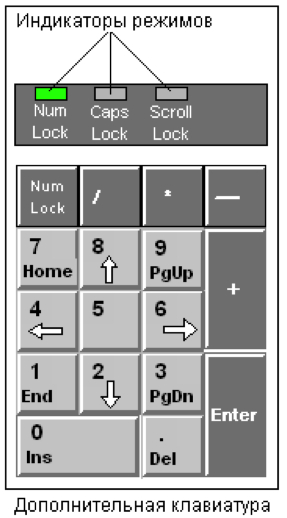
When enabled, this mode is also displayed by the indicator in the upper right corner of the keyboard, signaling that additional keyboard in work. Now, in addition to entering numbers from the field of the main keyboard, they can also be entered from the additional. However, those symbols that are applied to the keys of the additional keyboard along with the numbers will not work.
In most cases, the described keyboard fields are enough for work, but for those who like to work with a compact digital and control keyboard"A la calculator" there is one more additional field of keys - the rightmost one. This field is called the additional keyboard, in contrast to the main keyboard field.
When you press on this block of keys with the designation of numbers, the numbers are printed out, but with one condition - when the "NumLock" key is turned on. Numeric keys when the "NumLock" key is off, they perform functions of a different plan. The "End" key is duplicated by pressing the "1" key on the main keyboard and the "Home" key is duplicated with the "7" key also on the main keyboard.
The same keys move the cursor to the end and beginning of the line. When you press the "3" and "9" keys, duplication occurs on the main keyboard using the "PageUp" and "PageDown" keys, respectively. These same keys move the cursor up and down one screen. When you press the "2", "4", "8", "6" keys, the cursor is controlled, which means that the operation is dubbed with the arrow keys.
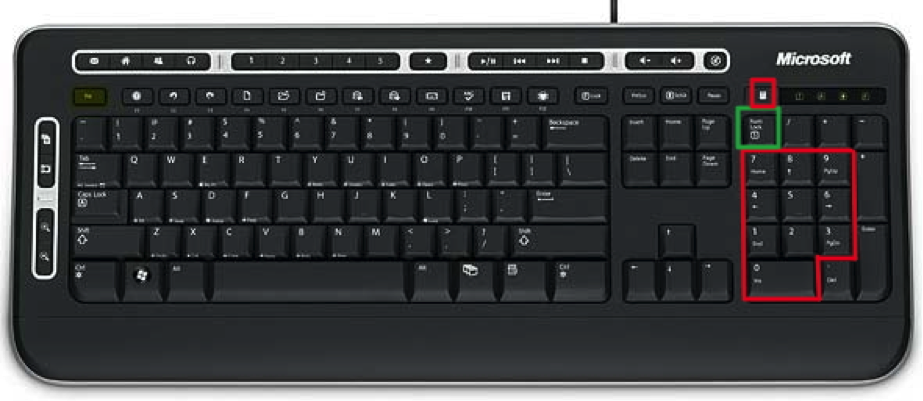
Space key - this key creates spacing between letters.
Spacebar - The largest key located under the block alphanumeric keys, is used to enter a blank character, regardless of the case switch.
Function of the "Space" key.
When using a key, words or symbols are separated from each other. But this key has an additional mode. In the replacement mode, which you can turn on with the "Insert" key, pressing the "Space" key enables the function, which is the same as when you press the "Delete" key (this key erases characters on the right).

Backspace key - pressing this key deletes the character to the left of the cursor.
BackSpace or Left Arrow key functions.
When you press this key, delete the selected one character or all the text on the left. When using this key in the file manager, we move up one level. And when viewing photos, pressing this key, we go back one photo.
By using the Alt + BackSpacr keys together, we undo the action that was performed before.
![]() Key
Key
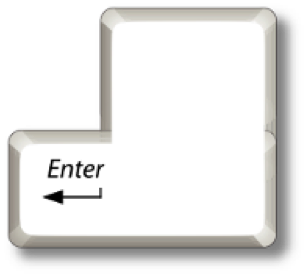
When, when performing work on the computer, you use the numeric keyboard, which is on the right, then it is much better to use the "Enter" key, which is located on the same block.
Delete key is designed to delete an object, such as a folder, file, etc .:
- in the text, the character is deleted to the right of the current cursor position (with the line shift to the left);
- in folder windows, the selected objects of the file system are deleted to the Trash.
Also remove unnecessary file by pressing together the keys "Shift + Delete". Shift keys are marked with a green frame. Just keep in mind that in this case the file will not be deleted through the trash can and in this case it cannot be restored.
The "Delete" key, indicated by a blue frame, located on the block numeric keypad, together with the "." performs the same actions when the "NumLock" key is off.
It is possible to open the "Task Manager" by pressing the key combination "Ctrl + Alt + Del". These Ctrl and Alt keys are denoted by beige frames.
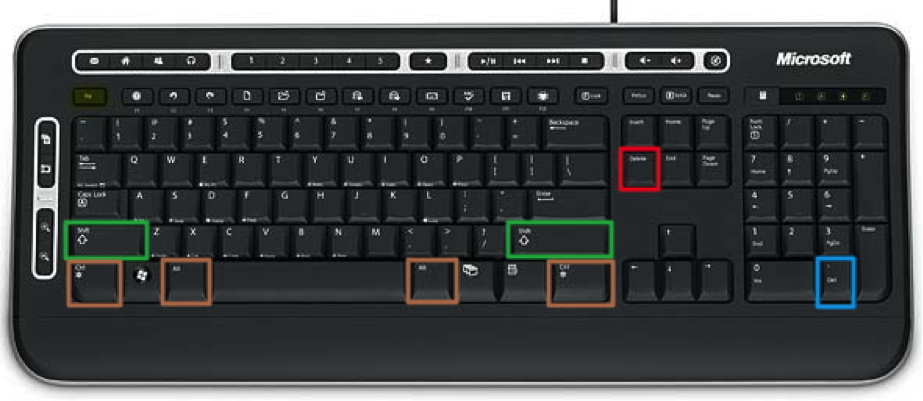
Key
- in the text, you switch between the modes of insertion and replacement of symbols or inserting a fragment from the clipboard (depending on the settings of Microsoft Word). If the "insert" mode is enabled, then when you print, the right word will move to the right between two words, and the text you enter expands the words and is printed between them. In this mode, the text appears to be inserted and pushes the entire end of the phrase to the right.
But with the "replace" mode, if you insert a word between two words, then the word located on the right is replaced by the word that you insert .;
- in programs like Total commander objects are selected.
If you press the Inset key, the text will be printed on top of what was printed, while erasing the last one. Pressing this key again will terminate this action.
The "Insert" key located in the blue frame, which is located on the numeric keypad block, together with the number "0" works only when the "NumLock" key is disabled.
We will be able to make a copy of the text after its selection, if we apply the key combination "Ctrl + Insert". And when we use the Shift + Insert keys together, it becomes possible to insert text.
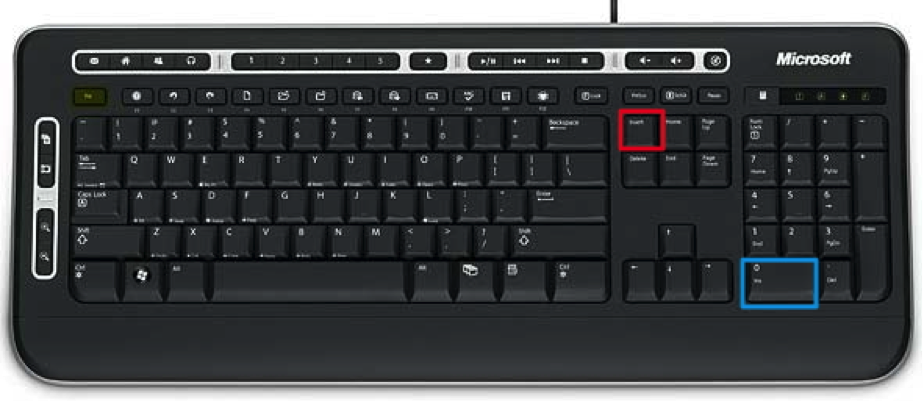
PgUp, PgDn, End, Home keys intended for cursor control.
Home key
moves the cursor to the beginning of the line, and End key
to the end of the line "), as well as either to the beginning of the list or to the end of the list. 
Keyboard shortcut
Keyboard shortcut
PgUp key moves the cursor to the top of the page, and PgDn key - at its end.
Functions by keys "PageUp" and "PageDown".
The use of these two keys is used when working with text editors, or when working with documents, where the height of the information is much greater than the height of your screen and it becomes necessary to scroll in height. These keys are marked with a red rectangle.
And the "PageUp" and "PageDown" keys, which are indicated by a blue rectangle and are located on the numeric keypad, only when the "NumLock" key is off, together with the numbers "3" and "9", scroll the screen down or up. The state of the "NumLock" key is monitored by the indicator light (the indicator light is on when the key is on).

 Key
Key
Keys
Functions with the "Ctrl" and "Alt" keys.
By using these keys, you expand the capabilities of others with keys. By using these keys in different variations, you perform different actions.
Ctrl + Alt + Del keys these keyboard shortcuts open the Task Manager.
Combination Ctrl + A keys selects all objects at once, such as folders, files, text, etc.
Combination Ctrl + X keys cuts the selected object to the clipboard, such as test, files, folders, etc.
Keyboard shortcut Ctrl + C copies some object to the clipboard, such as files, folders, etc.
Keyboard shortcut Ctrl + V pastes the copied file or folder from the clipboard.
Keyboard shortcut Ctrl + N allows you to create a new document in various programs.
Keyboard shortcut Ctrl + Z undo the last action.
Using the keys Ctrl + S the current document is saved.
Using the keys Ctrl + P the document is printed.
Ctrl + Esc - opening the "Start" menu. This can also be done by pressing the Windows key.
Using the keys Alt + Enter there is a transition to full screen mode and back, for example, if you press these keys in KMPlayer, WindowsMediaPlayer, MediaPlayerClassic, they expand to full screen.
Alt keys and keys 0 through 9 located on the right side of the keyboard allow you to enter arbitrary characters that are not on the keyboard. In order to enter arbitrary characters, you must press the Alt key and, without releasing it, press the desired number located on the right side of the keyboard.
Keyboard shortcut Alt + F4 closes the active application.
Keys Alt + Tab allow you to switch between open windows. A panel with all open applications appears in the center of the screen, and when you select the active window, you need to press the Tab key several times without releasing the Alt key.
Combination Alt + Space (space) opens the window's system menu, with which you can restore, move, maximize, minimize and close the window without using the mouse.
Alt + Shift or Ctrl + Shift - switching keyboard layouts.
Windows key usually found between the Ctrl and Alt keys. When you press it, the Start menu appears.
And by using the key with various options together with other keys, you speed up the launch of programs.
When you press the keys Win + E My Computer explorer will open.
When you press the keys Win + D minimizes all active windows.
Keyboard shortcut Win + L allows you to switch between users or lock a workstation. The keyboard shortcut Win + F1 brings up the Help and Support Center.
When you press the keys Win + F the search window will open.
When you press the keys Win + Ctrl + F the computer search window will open.
With help Win + D you can minimize all windows and show the desktop, and the keys Win + M minimizes all windows except dialog ones.
Win + E opens the My Computer folder.
Win + F - opens a window to search for a file or folder.
When you press the keys Win + PauseBreak the System Properties dialog box will open.
Key<Контекст> calls the context menu of the object on which the mouse pointer is currently located.
When using the key, we invoke the menu in the same way as when clicking on the right mouse button. This menu corresponds to the program that is included for your work. If you are on the "Desktop", then pressing this key, you open the menu corresponding to the active element of the Desktop.
 Cursor keys (navigation keys)
.
Performs various actions related to cursor movement:
Cursor keys (navigation keys)
.
Performs various actions related to cursor movement:
- in the text move the cursor one position in the specified direction;
- on the Desktop and in the folder window, transfer the selection to another object;
- in the menu, transfer the selection to the next command;
- in tables, move the cursor between cells.
These keys are also used in many games to control objects.
Also, these keys are used in many programs, for example, to move through the pages of a document or when viewing photos to move to the next image.
Browser keyboard shortcuts
To zoom in or out on a page, just hold down Ctrl key and roll the mouse wheel. Up - the scale will increase, down - accordingly, it will decrease. The same can be done by simply pressing + or - while holding down Ctrl. To restore the font size, use the keyboard shortcut Ctr + 0 .
And the use Shift keys and the mouse wheel allows you to navigate through the history of the tabs: Shift - scroll the wheel up - move forward through the history, Shift - scroll down the wheel - move backward through the history.
If in the browser you need to open a new page in a separate tab, then you can hold down Ctrl key and click on the desired link. New page will open in a separate tab.
Alt + Home keys return to home page, a Ctrl + R (or F5) refresh the page. To force the update without using cached data, use the keys Ctrl + F5 or Ctrl + Shift + R .
By pressing the keys Ctrl + S , you can save the page to your computer, and the keys Ctrl + P allow you to print the page you want. Hotkeys Ctrl + G, Ctrl + F, Shift + F3, Ctrl + K are designed to be searched on the current page or on the Internet.
Features of the laptop keyboard.
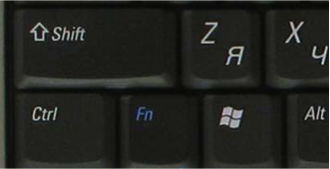 Since a laptop keyboard, by definition, should take up little space, many functions are "hidden" on it. And in order to find them, there is a magic key
Since a laptop keyboard, by definition, should take up little space, many functions are "hidden" on it. And in order to find them, there is a magic key
Labels or symbols that are the same color as
- with F2 - turns the adapter on and off wireless(Wi-Fi);
- with F3 - opens the mail program;
- with F5 - decreases the brightness of the monitor;
- with F6 - increases it;
- with F7 - turns the monitor on and off;
- with F10 - enables and disables the built-in speakers;
- with F11 - lowers the speaker volume;
- with F12 - increases it;
- the screen brightness is increased by pressing the key where there is a "big sun" (there may be a "sun" icon in combination with the "increase" icon);
- decrease - on the contrary, the one where the "small sun" (or maybe the "sun" icon in combination with the "decrease" icon);
- keys with “loudspeaker” icons in combination with “more” or “less” icons - increase / decrease the volume;
- crossed out mouse - disable / enable the TouchPad;
- crossed out loudspeaker - mute / unmute, etc.
Combining function keys with the Fn key may vary depending on different types keyboard, so you can clarify them in the user manual for the device, or be guided by the icons (usually of a different color) on the keys next to or below its main meaning.
Look carefully, without rushing, at the keyboard of your laptop, put the instructions attached to it next to it, spend some time mastering all these miracles and they will become familiar to you.
No related posts.
In contact with
Many people don't like the keyboard. It seems to them that the keyboard is only for typing. Did you know that using the keyboard you can fully control your computer?
In this article, I have compiled descriptions for all keyboard keys to try and make your life easier.
Description of keyboard keys
The main device for manual input of information is the keyboard. The keyboard is used to enter data into the computer memory (text and numbers), as well as to control its operation. The standard keyboard has 101 keys that can generate 256 different characters.
All keys are divided into the following groups:
- alphanumeric keys;
- cursor control keys;
- function keys;
- control keys;
- numeric keys.
For a hint, click on the key you are interested in.
Alphanumeric keys
The alphanumeric keys are the largest group of keys. They contain images of letters, numbers, action marks, punctuation marks, and some other signs. Pressing these keys leads to the appearance of the corresponding characters on the screen.
In keyboards that are used in Russia and neighboring countries, the keys of this group contain, in addition to images of Latin letters, also images of letters of the Russian alphabet. Switch between English and Russian layouts (when working in Windows environment) is carried out by pressing the key combination Ctrl + Shift or Alt + Shift.
A set of key combinations on the keyboard is carried out as follows: one key is held down, the other key is pressed and released, and then the first key is released. If the combination includes three keys, then the first two are held down, and the third is pressed and released.
Entering capital letters is carried out by pressing the corresponding keys while holding down the Shift key. Also, using the Shift key, the upper character is typed on the number keys. So, for example, to enter the left parenthesis (you need to press the key combination Shift + 9. Here 9 is the lower character on the keys with 9 and (.
If you need to enter only large letters for a long time, you can lock the upper case by pressing the Caps Lock key. The corresponding indicator on the keyboard lights up. Now, when you press a key with a letter, a large letter will be displayed on the screen, and to type a small letter, you need to additionally press the Shift key. The Caps Lock key does not apply to keys that do not have letters, but characters.
Function keys F1,…, F12 different programs ascribe different actions. Therefore, in the general case, we can only say that pressing the F1 key leads to the display of help for working with the program (although there are exceptions here too). From the help, in most cases, you can learn about the purpose of other function keys.
F1- Calling "Help" Windows. When you click from the window of any program - call the help of this program.
F2- Rename the selected object on the desktop or in the explorer.
F3- Open the search window for a file or folder (on the desktop and in the explorer).
F4- Open a drop-down list (for example, a list of the address line in the window "My Computer" or in the explorer).
F5- Refresh the active window (open web page, desktop, explorer).
F6- Switch between screen elements in a window or on the desktop. In Explorer and Internet Explorer, navigate between the main part of the window and the address bar.
F7- Spell checker (in Word, Excel).
F8-When loading the OS - select the boot mode. Turn on enhanced text selection in Word. The selection of a fragment from the start to the end position of the cursor occurs without holding the key Shift... Second keystroke F8 highlights the word closest to the cursor. The third is a sentence containing it. Fourth - paragraph. Fifth is the document. The easiest way to clear the last selection is by pressing the keyboard shortcut Shift + F8... You can disable the mode by pressing Esc.
AppsKey - opens the context menu for the selected object (equivalent to right-clicking).
Enter- Confirmation of selection. Same as double-clicking on an object. Clicking on the currently active button in the dialog. Often - clicking on the "default" button in the dialog. When entering commands from the keyboard - completion of the command input and transition to its execution. When typing - jump to a new paragraph.
Cursor control and additional keys.
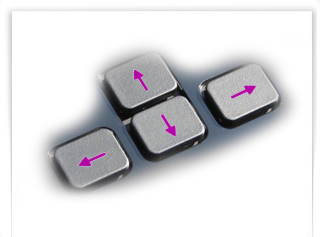 Up, Down, Right, and Left Arrows - Allows you to navigate through the menu items. Move the input cursor to the corresponding side by one position. The action of these keys in many programs can be modified using the service keys, primarily SHIFT and CTRL.
Up, Down, Right, and Left Arrows - Allows you to navigate through the menu items. Move the input cursor to the corresponding side by one position. The action of these keys in many programs can be modified using the service keys, primarily SHIFT and CTRL.
Home- move the cursor to the beginning of the current line of the document or to the beginning of the file list.
End- move the cursor to the end of the current line of the document or to the end of the file list.
PageUp / PageDown- move the cursor one page up or down. The term “page” usually refers to the portion of the document that is visible on the screen. Used to "scroll" through content in the current window.
PrtScn (Print Screen)- Takes a screenshot and places it on the clipboard. Alt + PrtScn- copying a screenshot of the currently active window (application) to the clipboard.
ScrLk (Scroll Lock)- refers to the service keys. Its short explanation is scroll lock. It is intended for such a mode of displaying on the screen, in which pressing the cursor keys leads to a shift not of the cursor as such, but of the entire contents of the screen. Now this key is used for this purpose very rarely, but, for example, in Excel it works. This is very useful when editing large tables.
tell friends
In contact with
 Bugs in Singularity?
Bugs in Singularity? Just Cause 2 crashes
Just Cause 2 crashes Terraria won't start, what should I do?
Terraria won't start, what should I do?